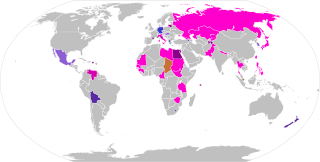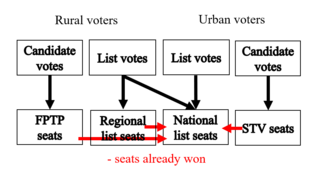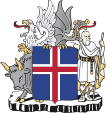
Proportional representation (PR) refers to any type of electoral system under which subgroups of an electorate are reflected proportionately in the elected body. The concept applies mainly to political divisions among voters. The essence of such systems is that all votes cast – or almost all votes cast – contribute to the result and are effectively used to help elect someone. Under other election systems, a bare plurality or a scant majority are all that are used to elect candidates. PR systems provide balanced representation to different factions, reflecting how votes are cast.

Single non-transferable vote or SNTV is an electoral system used to elect multiple winners. It is a semi-proportional variant of first-past-the-post voting, applied to multi-member districts where each voter casts just one vote. It can also be seen as a variant of limited voting where each elector votes only once.

Mixed-member proportional representation is a type of representation provided by some mixed electoral systems which combine local winner-take-all elections with a compensatory tier with party lists, in a way that produces proportional representation overall. Like proportional representation, MMP is not a single system, but a principle and goal of several similar systems. Some systems designed to achieve proportionality are still called mixed-member proportional, even if they generally fall short of full proportionality. In this case, they provide semi-proportional representation.
An electoraldistrict, sometimes called a constituency, riding, or ward, is a geographical portion of a political unit, such as (a country, state or province, city, or administrative region, created to provide the voters therein with representation in a legislature or other polity. That legislative body, the state's constitution, or a body established for that purpose determines each district's boundaries and whether each will be represented by a single member or multiple members. Generally, only voters who reside within the district are permitted to vote in an election held there. The district representative or representatives may be elected by single-winenr first-past-the-post system, a multi-winner proportional representative system, or another voting method.

Parliamentary elections were held in Hungary on 9 April 2006, with a second round of voting in 110 of the 176 single-member constituencies on 23 April. The Hungarian Socialist Party (MSZP) emerged as the largest party in the National Assembly with 186 of the 386 seats, and continued the coalition government with the Alliance of Free Democrats (SZDSZ). It marked the first time a government had been re-elected since the end of Communist rule. To date, this is the most recent national election in Hungary not won by Fidesz-KDNP, and the last in which the victorious party did not win a two-thirds supermajority in parliament.
Parliamentary elections were held in Iceland on 10 May 2003. The Independence Party remained the largest party in the Althing, winning 22 of the 63 seats. The coalition government of the Independence Party and Progressive Party remained in office, with Davíð Oddsson continuing as prime minister.

Parliamentary elections were held in Russia on 12 December 1993. They were the first parliamentary elections in post-Soviet Russia and the only time to the Federation Council, with future members appointed by provincial legislatures and governors.
Parliamentary elections were held in Iceland on 30 June 1946. The Independence Party remained the largest party in the Lower House of the Althing, winning 13 of the 35 seats.
Parliamentary elections were held in Iceland on 23 and 24 October 1949. The Independence Party remained the largest party in the Lower House of the Althing, winning 13 of the 35 seats.
Parliamentary elections were held in Iceland on 28 June 1953. The Independence Party remained the largest party in the Lower House of the Althing, winning 14 of the 35 seats.
Parliamentary elections were held in Iceland on 24 June 1956. The Independence Party remained the largest party in the Lower House of the Althing, winning 13 of the 35 seats.
Parliamentary elections were held in Iceland on 28 June 1959. The Independence Party and the Progressive Party both won 13 seats in the Lower House of the Althing. Following the tie, electoral reforms were introduced and early elections were held in October.
Parliamentary elections were held in Iceland on 25 April 1987. The Independence Party remained the largest party in the Lower House of the Althing, winning 12 of the 42 seats.
Electoral districts go by different names depending on the country and the office being elected.
Electoral reform is a change in electoral systems which alters how public desires are expressed in election results.
Parliamentary elections were held in Iceland on 27 October 1923. Voters elected all 28 seats in the Lower House of the Althing and eight of the fourteen seats in Upper House. The Citizens' Party, a loose collection of conservatives, emerged as the largest party in the Lower House, winning 16 of the 28 seats.
Parliamentary elections were held in Iceland on 24 June 1934. They were the first held after reforms to the electoral system that increased the number of seats in the Lower House from 28 to 33 and ensured that all members of the Althing were elected at the same election. The Independence Party emerged as the largest party in the Lower House, winning 14 of the 33 seats.
Early parliamentary elections were held in Iceland on 18 and 19 October 1942. They were held after reforms were made to the electoral system following the July elections. The Independence Party emerged as the largest party in the Lower House of the Althing, winning 13 of the 35 seats.

A mixed electoral system is one that uses different electoral systems to elect different seats in a legislature. Most often, this involves a winner-take-all component combined with a proportional component. The results of the combination may be mixed-member proportional (MMP), where the overall results of the elections are proportional, or mixed-member majoritarian, in which case the overall results are semi-proportional, retaining disproportionalities from the majoritarian component. Systems that use multiple types of combinations are sometimes called supermixed.

Rural–urban proportional representation (RUP), also called flexible district PR, is a supermixed electoral system which combines the use of single- and multi-member constituencies in a lower tier and top-up seats in an upper tier to meet the different needs of both rural and urban areas, while protecting the objective of proportionality. The term was coined by Fair Vote Canada, which devised a rural–urban system with the intention of meeting the special challenges of Canada's geography, which includes wide-flung, sparsely populated areas.






